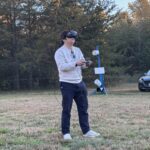ESSIC Visiting Assistant Research Scientist Scott Rudlosky launched a new blog on the ESSIC website today, entitled “It’s Severe.” The posts will focus on presenting information to the public about extreme weather events such as flooding, wildfires, and lightning.
The subject of the first post, lightning, is a particularly relevant topic this week: NOAA’s Lightning Safety Awareness Week. According to the National Weather Service, there have been five deaths from lightning strikes so far this year in the U.S. This compares to 26 deaths in 2011, the fewest in a five-year span that began with 45 deaths in 2007.
Rudlosky said that lightning is also a relevant subject because of severe lightning storms that swept through the D.C. region on June 22.
He also said in the post that the storm revealed the value of the Washington D.C. Lightning Mapping Array, a set of ten sensors that monitor very high frequency radio waves emitted by lightning. The post provides 3D animations to illustrate this.
“These are different forms of outreach and the goal is to inform the public,” Rudlosky said, referring to the new blog.
Rudlosky is in charge of local maintenance of the WDCLMA. He is joined by Dustin Shea and NASA’s Jeff Bailey.
Shea, who finished the first year of his master’s at Maryland this year, started as a graduate research assistant officially on June 1 but started working with ESSIC before that as a volunteer. He said he became an hourly employee and eventually was taken on as a GRA.
Rudlosky said Shea has travelled to the locations of the various sensors throughout June and brought the tenth sensor online last Friday.
Bailey serves as a hardware and software expert for the WDCLMA, and he helps with maintenance of the sensor, Rudlosky said.
“He can run tests on something, and figure it out way before we could,” Shea said of Bailey, who works with Shea when he visits the sensor locations.
Rudlosky said that new blog entries will most likely be posted on a monthly basis.
“The events in Colorado and Florida have helped to motivate this blog and use CICS scientists,” Rudlosky said of the inspiration behind the blog. “The idea is that scientists who have their hands on really cool data sets can show the public this information.”





